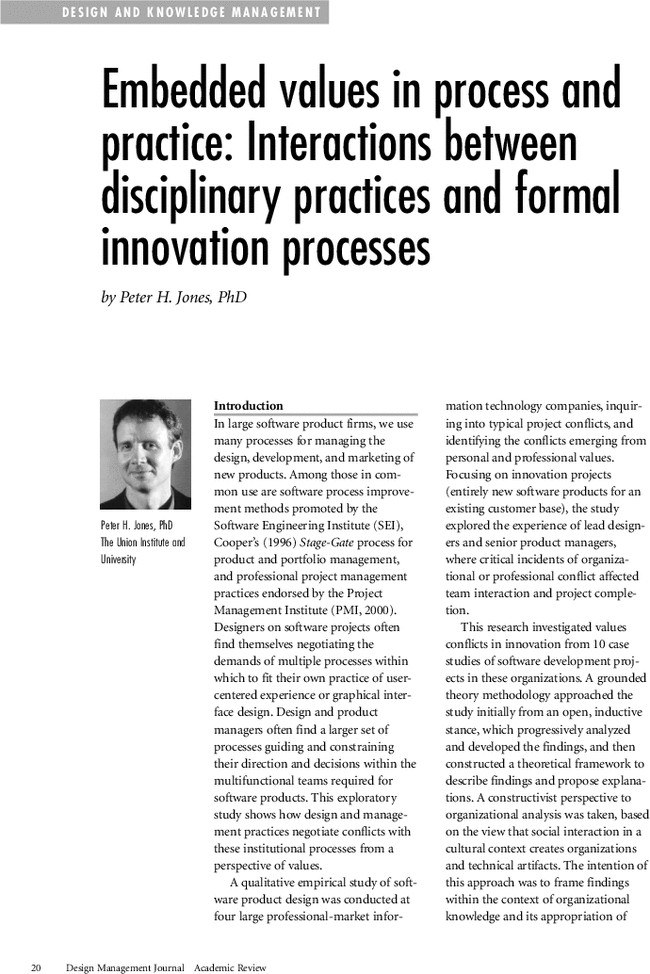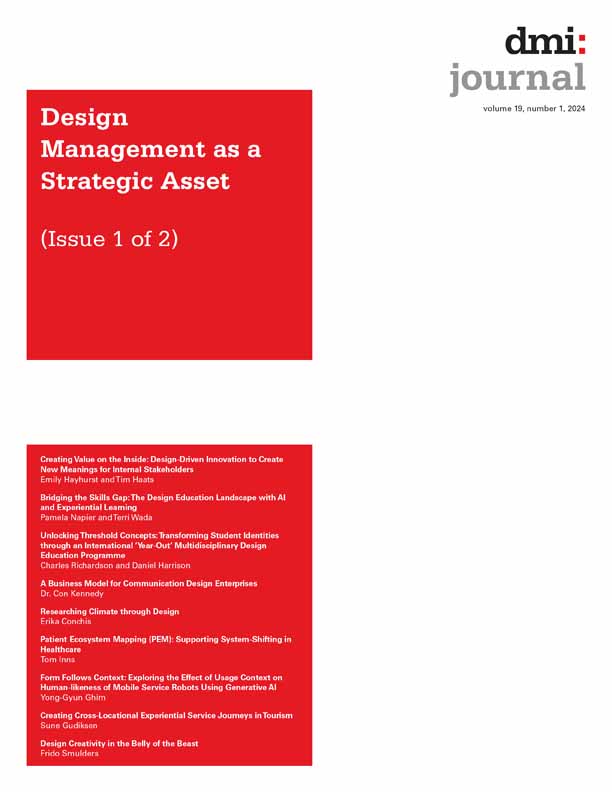Full Access
Embedded values in process and practice: Interactions between disciplinary practices and formal innovation processes

References
- Argyris, C. 1992. “ Why Individuals and Organizations Have Difficulty in Double Loop Learning. On Organizational Learning ( 7–38). Cambridge: Blackwell Publishers.
- Banathy, B. H. 1996. Designing Social Systems in a Changing World. New York: Plenum Publishing Co.
- Baum, J.A.C. and C. Oliver 1992. “Institutional Embeddedness and the Dynamics of Organizational Populations. American Sociological Review, 57, 540–559.
- Blackler, F. 1993. “Knowledge and the Theory of Organisations: Organisations as Activity Systems and the Reframing of Management. Journal of Management Studies, 30, 863–884.
- Blackler, F. 1995. “Knowledge, Knowledge Work, and Organisations. Organisation Studies, 16 (6), 1021–1046.
- Braa, K. and R. Vidgen 1997. “ An Information Systems Research Framework for the Organizational Laboratory.” In M. Kyng and L. Mathiassen (eds.) Computers and Design in Context ( 381–400). Cambridge, MA: MIT Press.
-
Clegg, S.
1994. “Weber and Foucault: Social Theory for the Study of Organizations.
Organization, 1 (1), 149–178.
10.1177/135050849400100115 Google Scholar
- Cooper, R.G. 1996. Product Leadership: Creating and Launching Superior Products. Cambridge, MA: Perseus Books.
- Crosby, L.A., M.J. Bitner, and J.D. Gill 1990. “Organizational Structure of Values. Journal of Business Research, 20 (2), 123–134.
- Curtis, B., H. Krasner, and N. Iscoe 1988. “A Field Study of the Software Design Process for Large Systems. Communications of the ACM, 31 (11), 1268–1287.
- Ehn, P., T. Meggerle, O. Steen, and M. Svedemar 1997. “ What Kind of Car Is this Sales Support System? On Styles, Artifacts, and Quality-in-use.” In M. Kyng and L. Mathiassen (eds.) Computers and design in context ( 112–143). Cambridge, MA: MIT Press.
- England, G.W. 1967. “Personal Value Systems of American Managers. Academy of Management Journal, 10, 53–68.
- Friedman, B. 1997. Human Values and the Design of Computer Technology. Cambridge, UK: Cambridge University Press.
- George, J.M. and G.R. Jones 1997. “Experiencing Work: Values, Attitudes, and Moods. Human Relations, 50 (4), 393–417.
- Glaser, B.G. and A.L. Strauss 1967. The Discovery of Grounded Theory. Chicago: Aldine.
- Greenbaum, J. 1993. “ A Design of One's Own: Towards Participatory Design in the United States.” In D. Schuler and A. Namioka (eds.) Participatory Design: Principles and Practice ( 27–37). Hillsdale, NJ: Lawrence Erlbaum Associates.
- Grudin, J. 1993. “ Obstacles to Participatory Design in Large Product Development Organizations.” In D. Schuler and A. Namioka (eds.) Participatory Design: Principles and Practice ( 99–119). Hillsdale, NJ: Lawrence Erlbaum Associates.
-
Hanseth, O. and
E. Monteiro
1997. “Inscribing Behavior in Information Infrastructure Standards.
Accounting, Management, and Information Technology, 7 4, 183–211.
10.1016/S0959-8022(97)00008-8 Google Scholar
- Herbsleb, J.D. and E. Kuwana 1993. “ Preserving Knowledge in Design Projects: What Designers Need to Know.” Conference Proceedings on Human Factors in Computing Systems, InterCHI 1993, April 1993, Amsterdam. New York: Association for Computing Machinery, 7–14.
- Hill, S. 1981. Competition and Control at Work. Cambridge, MA: MIT Press.
-
Hinings, C.R.
1997. “Reflections on Processual Research.
Scandinavian Journal of Management, 13 (4), 493–503.
10.1016/S0956-5221(97)00023-7 Google Scholar
- Hinings, C.R., L. Thibault, T. Slack, and L.M. Kikulis 1996. “Values and Organizational Structure. Human Relations, 49 (7), 885–917.
- Jewett, T. and R. Kling 1990. “ The Work Group Manager's Role in Developing Computing Infrastructure.” Proceedings of the ACM Conference on Office Information Systems, Boston. New York: Association for Computing Machinery.
- Jones, J.C. 1992. Design Methods. New York: John Wiley and Sons.
-
Kling, R.
1996. “ The Centrality of Organizations in the Computerization of Society.” In R. Kling (ed.) Computerization and Controversy: Value Conflicts and Social Choices, 2nd ed., ( 108–112). New York: Academic Press.
10.1016/B978-0-12-415040-9.50098-1 Google Scholar
- Kumar, K. and N. Bjorn-Anderson 1990. “A Cross-Cultural Comparison of IS Designer Values. Communications of the ACM, 33 (5), 528–538.
- Margolin, V. 1998. “Design for a Sustainable World. Design Issues, 14 (2), 83–92.
- Maslow, A.H. 1971. The Farther Reaches of Human Nature. New York: Viking Press.
-
McDonnell, J.
1997. “Descriptive Models for Interpreting Design.
Design Studies, 18, 457–473.
10.1016/S0142-694X(97)00012-4 Google Scholar
-
Nardi, B.A. and
V.L. O'Day
1999. Information Ecologies: Using Technology with Heart. Cambridge, MA: MIT Press.
10.7551/mitpress/3767.001.0001 Google Scholar
- Norrgren, F. and J. Schaller 1999. “Leadership Style: Its Impact on Cross-Functional Product Development. Journal of Product Innovation Management, 16 (4), 377–384.
- Orlikowski, W.J. 1993. “CASE Tools as Organizational Change: Investigating Incremental and Radical Changes in Systems Development. MIS Quarterly, 17, 3–29.
- Orlikowski, W.J. and D. Robey 1991. “Information Technology and the Structuring of Organizations. Information Systems Research, 2 (2), 143–169.
- Orlikowski, W.J. and D.C. Gash 1994. “Technological Frames: Making Sense of Information Technology in Organizations. ACM Transactions on Information Systems, 12 (2), 174–207.
- Papanek, V. 1996. “ The Future Isn't What It Used to Be.” In V. Margolin and R. Buchanan (eds.) The Idea of Design, ( 56–69). Cambridge, MA: MIT Press.
- Polanyi, M. 1966. The Tacit Dimension. New York: Doubleday and Co.
-
Poltrock, S.E. and
J. Grudin
1994. “Organizational Obstacles to Interface Design and Development: Two Participant-Observer Studies.
ACM Transactions on Computer-Human Interaction, 1 (1), 52–80.
10.1145/174630.174633 Google Scholar
- Project Management Institute, Inc. 2000. A Guide to the Project Management Body of Knowledge PMBOK Guide, 2000 Edition. Newton Square, PA.
- Robey, D. and M. Markus 1984. “Rituals in Information Systems Design. MIS Quarterly, 8 (1), 5–15.
- Robey, D. and M. Newman 1996. “Sequential Patterns in Information Systems Development: An Application of a Social Process Model. ACM Transactions on Information Systems, 14 (1), 30–63.
- Rokeach, M. 1973. The Nature of Human Values. New York: Free Press.
- Sachs, P. 1995. “Transforming Work: Collaboration, Learning, and Design. Communications of the ACM, 38 (9), 36–45.
- Saetnan, A.R. 1991. “Rigid Politics and Technological Inflexibility: The Anatomy of a Failed Hospital Innovation. Science and Technology and Human Values, 16 (4), 419–447.
- Sharrock, W. and B. Anderson 1996. “ Organizational Innovation and the Articulation of the Design Space.” In T. Moran and J. Carroll (eds.) Design Rationale, ( 429–451). Mahwah, NJ: Lawrence Erlbaum Associates.
- Star, S.L. 1995. “ The Politics of Formal Representations: Wizards, Gurus, and Organizational Complexity.” In S.L. Star (ed.) Ecologies of knowledge: Work and politics in science and technology, ( 88–118). Albany, NY: State University of New York.
- Star, S.L. and K. Ruhleder 1994. “Steps Toward an Ecology of Infrastructure.” In Proceedings of CSCW 94. Chapel Hill, NC, Oct. 22–26, 253–264.
- Strauss, A. and J. Corbin 1990. Basics of Qualitative Research. Thousand Oaks, CA: Sage Publications.
- Tang, J.C. 1997. “ Eliminating a Hardware Switch: Weighing Economics and Values in a Design Decision.” In B. Friedman (ed.), Human Values and the Design of Computer Technology, ( 259–270). Cambridge, UK: Cambridge University Press.
- Walsham, G. and T. Waema 1994. “Information Systems Strategy and Implementation: A Case Study of a Building Society. ACM Transactions on Information Systems, 12 (2), 150–173.
- Walz, D.B., J.J. Elam, B. Curtis 1993. “Inside a Software Design Team: Knowledge Acquisition, Sharing, and Integration. Communications of the ACM, 36 (10), 63–77.
- Zuboff, S. 1988. In the Age of the Smart Machine. New York: Basic Books.




